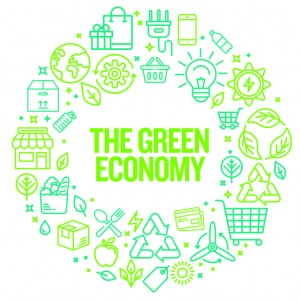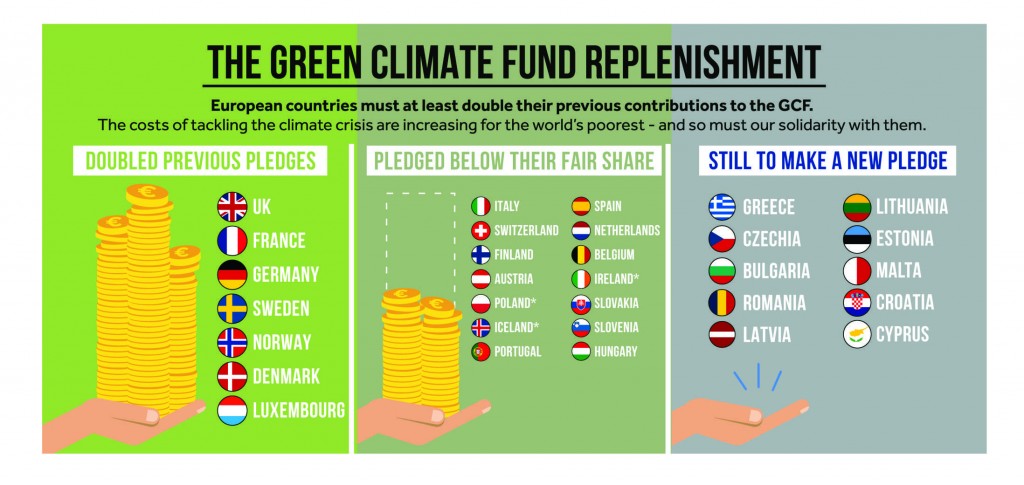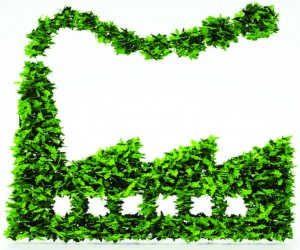Green Economy2
The world is not in a good shape at the moment — food prices are rising, freshwater sources are depleting, energy prices are soaring, biodiversity is dying out, intense storms are damaging towns and cities, while floods and droughts are threatening the livelihoods of millions. Clearly, climate change is playing a major role in taking its toll on human populations, just as the scientists had predicted it would. And the rate of change is accelerating. In these circumstances, it is imperative for climate change-vulnerable countries like Pakistan to pursue ‘Green Economy’ that can put them on the path of sustainable development through efficient and environment-friendly use of the natural resources.
The global recession has brought new attention to chronic structural flaws in current economic models and assumptions. This global crisis, coupled with climate change, environmental degradation and poverty, triggered worldwide policy debate on the need for a new economic paradigm. A global response, “Rethinking the Economic Recovery: A Global Green New Deal,” was first proposed by United Nations Environment Program (UNEP) in 2009 to revive the global economy and boost employment; while simultaneously accelerating the fight against climate change, environmental degradation and poverty. As economies worldwide struggle to recover, many are taking a closer look at the broad concept of a “Green Economy,” one that simultaneously promotes sustainability and economic growth. What would this type of economy look like, and how could we get there? Let’s find out the answers:
Introduction
Green economy is the new buzzword that is replacing “sustainable development” in the global arena. The concept of green economy was first created in 2008 to get governments to spend money on the environment and it was presented, in 2009, by the UNEP, as a way forward in response to the global financial crisis. The idea behind it was to shift investments away from business as usual to green activities making economic sense.
What is a Green Economy?
A green economy can be thought of as an alternative vision for growth and development; one that can generate growth and improvements in people’s lives in ways consistent with sustainable development. A green economy promotes a triple bottom line: sustaining and advancing economic, environmental and social well-being.
The green economy requires that economic development is decoupled from the use of resources and environmental degradation. Decoupling refers to reducing the environmental impact (in terms of both resource use and the generation of pollution and wastes) associated with any economic activity. A distinction can be made between relative decoupling (a reduction in environmental impact per unit of economic output), and absolute decoupling (a reduction in the overall environmental impact of an economy).
Definitions
“Green Economy is one that results in improved human well-being and social equity, while significantly reducing environmental risks and ecological scarcities.”—United Nations Environment Programme, 2011
“Green economy is fostering economic growth and development while ensuring that natural assets continue to provide the resources and environmental services on which our well-being relies.” — Organisation for Economic Cooperation and Development, 2011
“Green economy is a fair and resilient economy, which provides a better quality of life for all, achieved within the ecological limits of one planet.” — Green Economy Coalition
Meaning
The green economy, therefore, presents an opportunity to reorient the economy along a development path which is (a) resource-efficient; and (b) generates low levels of carbon emissions. The green economy approach is an effort to focus sustainable development and poverty-reduction efforts on transforming economic activities and economies. Important components of the approach include the use of economic instruments, the creation of an investment-friendly environment, and directing public and private investment towards building natural capital stocks.
Principles
The most common green economy principles identified from a review of eight published sets of principles or characteristics are as under:
- The green economy is a means for achieving sustainable development.
- The green economy should create decent work and green jobs.
- The green economy is resource- and energy-efficient.
- The green economy respects planetary boundaries or ecological limits or scarcity.
- The green economy uses integrated decision making.
- The green economy measures progress beyond GDP using appropriate indicators/metrics.
- The green economy is equitable, fair and just – between and within countries and between generations.
- The green economy protects biodiversity and ecosystems.
- The green economy delivers poverty-reduction, well-being, livelihoods, social protection and access to essential services.
- The green economy improves governance and the rule of law. It is inclusive; democratic; participatory; accountable; transparent; and stable.
- The green economy internalises externalities.
Why green economy?
Humanity faces serious challenges in the coming decades: climate change, biodiversity loss, growing inequality, and more. These systemic global crises cannot be tackled in isolation, because they are all interconnected. Scientists have been calling for a major shift to clean energy technologies and energy efficiency in order to curb carbon emissions causing climate change. The UN’s Intergovernmental Panel on Climate Change in its special report on renewable energy sources and climate change mitigation called for nations around the globe to invest heavily in renewable energy so as to bring down prices and make it more affordable to everyone.
How will it help combat climate change?
Human activities that have released greenhouse gases into the atmosphere are the cause of recent climate change, often referred to as global warming. Climate change is the shift of average weather conditions over long-time horizons (decades and longer). The average temperature on the planet has been increasing in recent decades; resulting in more extreme and unpredictable weather across the world and a range of impacts on economic activity and human well-being. To combat climate change, we need to act now since the benefits of strong, early action on climate change can have significant and lasting benefits that improve the resilience of society.
The main human activities responsible for greenhouse gas emissions are the use of non-renewable fossil fuels, land-use change from deforestation and agricultural expansion, and other industrial activities. Many countries are signatories to the Kyoto Protocol (and related mechanisms under the United Nations Framework Convention on Climate Change), that commits countries to reduce greenhouse gas emissions through the adoption of a range of mitigation measures and defined emission reduction targets. The transition to a green economy, which is resource-efficient and low carbon, will therefore be essential in reducing GHG emissions and mitigating climate change by decoupling future growth from the use of non-renewable fossil fuels and other natural resources.
Challenges to a transition
The principal challenge is how we move towards an economic system that will benefit more people over the long run. Transitioning to a green economy will require a fundamental shift in thinking about growth and development, production of goods and services, and consumer habits. This transition will not happen solely because of better information on impacts, risks or good economic analysis; ultimately, it is about politics and changing the political economy of how big decisions are made.
The problem is vested interests. Those who benefit from the status quo are either overrepresented in, or have greater access to, institutions that manage natural resources and protect the environment. US climate legislation, for example, was defeated in no small part by resistance from fossil-fuel-based energy advocates.
The following steps would help create a more level policy-making playing field:
- Increase public awareness and the case for change. Greater visibility on the need for this transition can motivate voters and consumers – not just because of the costs but also the economic benefits generated by a Green Economy, such as new jobs and new markets. People will not adopt policies because they are green. They will do so when they believe it is in their interest.
- Promote new indicators that complement GDP. Planning agencies and finance ministries should adopt a more diverse and representative set of economic indicators that focus less exclusively on growth and track the pace and progress of development.
iii. Open up government decision-making processes to the public and civil society. This would help ensure policies are accountable to the public and not to vested and well-connected interests.
- Identify and take advantage of political leadership when available as this will be crucial in order to limit the undue influence of “dirty” economic holdouts.
Green Economy in Pakistan
There is no doubt that environmental degradation remains a serious, but politically unrecognized, challenge for Pakistan. Issues such as widespread air and water pollution which plague the country are costing its already stressed economy almost 6% of its GDP and draining away more than Rs 1 billion per day (WB report). Pakistan’s high vulnerability to climate change is now threatening to further add on to these costs. A German think-tank “Germanwatch” has placed Pakistan on the fifth spot on the list of countries most vulnerable to climate change in its Global Climate Risk Index for 2020. According to the report, Pakistan lost 9,989 lives, suffered economic losses worth $3.8 billion and witnessed 152 extreme weather events from 1999 to 2018 and based on this data, the think-tank has concluded that Pakistan’s vulnerability to climate change is increasing.
Green Economy and UN Climate Summit 2019
Although the global demand for green transition is growing, it is no longer seen as the responsibility of just the government, it is the responsibility of every public institution, company and citizen to do what they can in their domain. It was the pledge of more than 70 nations at the UN Climate Action Summit in New York on Sept 23 to make concrete plans now for how to reach the goal of climate neutrality by 2050. In Pakistan, however, there are still voices arguing against green transition. They say that Pakistan is responsible for only 1pc of carbon emissions, so it does not matter much anyway.
Climate aside, the strongest arguments for Pakistan are economic and with regard to resource survival. They are compelling.
Firstly, green transition in the energy sector would mean much lower electricity prices as well as a much smaller burden on Pakistan’s troubled trade balance. The energy sector in Pakistan primarily runs on fossil fuels—oil, gas and coal. Consequently, electricity is very expensive here, and this is making the country less competitive economically. The heavy dependence on imported oil and gas is also undermining Pakistan’s trade balance and is a major component of the current economic crisis.
Solar and wind turbines can produce electricity at half the price of oil and coal or better. With the help of pioneering wind turbine giant Vestas and others, Denmark has the world’s highest amount of electricity from renewables approaching 70pc in 2020, but, at the same time, has the lowest load-shedding and one of the lowest production cost levels in the world.
The message is clear: the more renewable sources for producing electricity, the better for the trade balance and for lower energy prices. And it would make Pakistani businesses much more price-competitive in the global markets.
Secondly, global consumers are turning to sustainable production, and soon this will also be reflected in tax incentives and regulations in Pakistan’s two biggest export markets: the EU and the US. Already, as many as two-thirds of consumers have a strong preference for sustainable products, and this trend is expected to strengthen over the coming years. Big enterprises like Carlsberg and Starbucks are taking out plastic from their line of products to meet those expectations.
Moreover, it is only a matter of time before an intensifying race to meet climate goals will impose sustainability standards on products being exported to, for instance, Europe. A little further down the line, Pakistan’s main export markets will also put in place far stricter regulations for products.
The message is clear: those who can produce sustainably will be the winners on the economic markets.
Thirdly, building a circular economy is crucial for Pakistan to preserve its resources. Pakistan is one of 10 countries in the world that will be most affected by climate change. Pakistan has numerous environmental and resource challenges that will have to be resolved quickly, if, for instance, water resources and the ability to grow agricultural crops are to be available also for future generations.
In Pakistan, 95% (World Bank) of water is used in agriculture. The lack of waste management is slowly but literally turning Pakistan into a wasteland. Air quality ranks among the poorest in the world and that has an impact on health standards.
The message is clear: sustainable handling of waste, protection of aquifers from pollution and saving on water resources are indispensable to Pakistan.
Solutions exist. Waste-to-energy and recycling solutions could make it possible to put a value on waste and thereby finance solutions. In Denmark, most waste is recycled, some is turned into energy and only one percent goes into a landfill. The newest state-of-the art waste-to-energy plant in Copenhagen can convert 500,000 tons of residual waste to energy every year practically without the emission of toxic fumes. The investment is expected to fully pay for itself through the sale of energy.
In October, Copenhagen hosted the C40 World Mayors Summit — with coordination among the largest cities around the world, including Karachi. Cities are responsible for 70% of global carbon emissions and 80% of energy use, and that is why green and smart solutions for cities are crucial for overall global green transition. Innovative solutions are being developed and shared here — and Pakistan can benefit directly.
For Pakistan, climate neutrality is not just something ‘nice to do’. It is a ‘need to do’ for survival. And on top of that, it just makes good economic sense.
The green entrepreneurs of today, whether countries or business companies, will be the global winners of tomorrow.
 Jahangir's World Times First Comprehensive Magazine for students/teachers of competitive exams and general readers as well.
Jahangir's World Times First Comprehensive Magazine for students/teachers of competitive exams and general readers as well.



